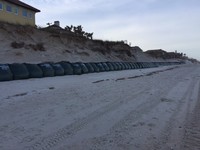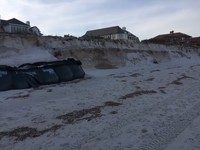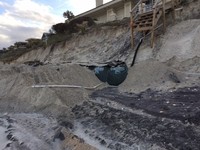


Following two consecutive years of devastating hurricane damage, residents of northern St. Johns County have found themselves facing a coastal crisis. With some homes collapsing onto the beaches already and others in danger of following suit, residents and elected officials alike are desperately seeking a solution, but it’s beginning to look like one won’t come easy.
“We had hired a coastal engineer and he surveyed our beach,” said Lori Moffett, a leader of the Save Ponte Vedra Beach initiative. “What he determined is we’ve lost 135 feet of width out of our beach since 1972 and about 80 feet since the 1980s. That equates to 2.5 million cubic yards of sand, which is equal to about 170,000 truckloads of sand. So, the problem predates Matthew and Irma. It’s been going on for decades, and the bottom line is we’re in a net loss position every year. The beach will not be rebuilt naturally.”
Although the problem is easy enough to identify, with less than four months before the start of the next hurricane season, the county is running short on time to find an answer.
“It’s all about funding,” Moffett said. “You can’t truck in almost 200,000 trucks of sand, so you have to dredge from the ocean. The coastal engineer has found a dredging site that’s 5 miles off the coast of Ponte Vedra, so where we are right now is trying to find the money. We’ve been working with the county, and what they’ve proposed is raising the bed tax from 4 to 5 percent. That would free up over $2 million a year for the St. Johns County coastline.”
The bed tax, formally known as the tourist development tax, is a charge on the revenue from short-term accommodation rentals of six months or less. According to the Florida Department of Revenue, most of Florida’s 67 counties currently impose a bed tax of 5 percent or higher. While in St. Johns the bed tax is 4 percent, neighboring Flagler and Clay counties tax residents at 5 percent, and in Duval County the tax is as high as 6 percent.
While there are limitations to how bed tax dollars can be spent, it is not unheard of for some of those funds to be designated for use in beach renourishment. In fact, some of St. Johns County’s bed tax dollars are already allocated towards renourishment in St. Augustine Beach. In this case, the proposed 1 percent tax increase would help to fund restoration of St. Johns County’s northern beaches – from Vilano Beach to Ponte Vedra Beach.
On Feb. 6, the proposal was reviewed and discussed at a meeting of the St. Johns County Board of County Commissioners.
“Our beaches are probably our most important natural asset not only from an environmental, but also an economic standpoint,” said Commission Chair Henry Dean. “We need to give immediate attention to our critical beach erosion that we have learned about. We have a crisis, and we have I think only one way out, and the first step is to increase the bed tax by 1 cent.”
Other commissioners were less certain that the tax increase was the county’s best path forward, however.
“I agree we have a catastrophe,” Commissioner Jimmy Johns said. “What I need to know is more details as to how we achieve the intended goal.”
Ultimately, in a 4-1 vote, the commissioners voted to move the process forward and obtain a recommendation from the Tourist Development Council on the proposal, after which the commissioners will vote once more on the proposal, with at least a 4-1 majority needed to approve and implement the tax increase. Commissioner Jeb Smith, the lone dissenting vote, advised the Recorder that he intends to discuss the proposal personally with residents next week.
While supporters of the proposal are hopeful that it will eventually be approved, an increase in the bed tax may not be the only avenue for beach renourishment funding. The budget deal President Donald Trump signed earlier this month, for instance, approved nearly $90 billion in disaster relief for those impacted by Hurricanes Harvey, Irma and Maria, as well as the recent California wildfires.
Whatever the funding source, however, with yet another potentially disastrous hurricane season on the horizon, most can agree that the need for a solution is pressing.
“We don’t have an option,” Moffett said. “This has to get done.”